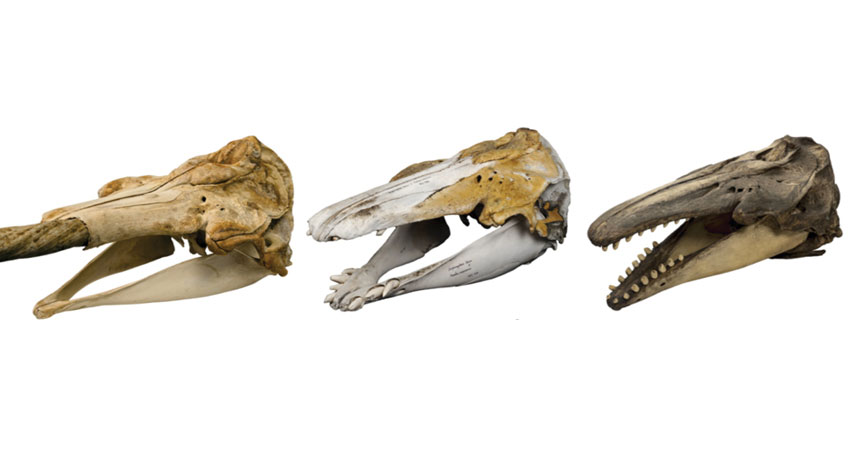
TELLTALE TEETH The skull of an unusual whale (center) killed decades ago resembles a cross between a beluga whale (right) and a narwhal (left). A genetic study confirms that the animal is a beluga-narwhal hybrid.
Mikkel Høegh Post/Natural History Museum of Denmark
- More than 2 years ago
Researchers have made a whale of a discovery — a hybrid of a beluga whale and a narwhal.
DNA analysis of the whale’s skull confirmed it to be the male offspring of a narwhal mother and a beluga father, researchers report June 20 in Scientific Reports.
The animal was one of three unusual whales caught during a subsistence hunt in 1986 or 1987 in western Greenland’s Disko Bay, and the only one with any known remains. The three whales were all uniformly gray, with pectoral fins shaped like belugas’ and tails shaped like narwhals’.
The Inuit hunter, who gave the skull to researchers, said that he’d never seen such odd whales before or since, says Eline Lorenzen, an evolutionary biologist and curator of the National Museum of Denmark at the University of Copenhagen where the skull is housed. Disko Bay is one of the few places where belugas and narwhals overlap during mating season.
Previous DNA analysis of the decades-old skull was “lousy,” Lorenzen says. So she and colleagues used techniques for analyzing ancient DNA to determine that the animal had a roughly 50-50 mix of beluga and narwhal DNA, making it a first-generation hybrid (SN: 11/11/17, p. 16). There’s no way to tell whether the hybrid whale was fertile. Analysis of isotopes, heavier or lighter variants of certain atoms, suggests that the hybrid may have had different feeding patterns than either parent species.
Before the new study, the clearest indication that the animal was neither pure beluga nor full narwhal came from its teeth, which were unlike those of both Arctic species, says Randall Reeves, a whale biologist who chairs the International Union for Conservation of Nature’s cetacean specialist group. Reeves helped in describing the skull as a potential hybrid decades ago but was not involved in the new research.
Beluga whales have 40 peglike teeth. Narwhal females have no teeth, while narwhal males have one, sometimes two, spiraled teeth that pierce through their lip forming the famous “tusk.” The male hybrid had forward-pointing grooved teeth, but not the long tusk tooth.
It’s not clear whether the tusk sometimes gets in the way of narwhal mating, but it’s a distinguishing characteristic that might warn a female beluga that a male narwhal is a different species. Female narwhals, on the other hand, have a similar size and shape to female belugas, and might be more easily mistaken for them, says Reeves, who is based in Hudson, Canada. “A female narwhal being impregnated by a male beluga is pretty believable.”
Still, the pairing is unusual, even shocking, to some researchers who have studied the species for years with hardly an inkling of such intermingling. The beluga and narwhal branches of the whale family tree split off about 5 million years ago — about the same time human and chimpanzee ancestors went their separate ways. Lorenzen’s team also detected no evidence of hybridization within the last 1.5 million years in the DNA of other belugas and narwhals So when the team presented the findings at a conference of beluga researchers held in Mystic, Conn., in March, “you could hear a pin drop when we said it was a first-generation hybrid,” Lorenzen says. “They were so surprised.”
Given how infrequently humans observe whales in the remote Arctic, it’s hard to say whether the hybrid is a fluke, says Kristin Laidre, a marine mammal biologist and narwhal expert at the University of Washington in Seattle. “I don’t think it’s a highly common thing,” or large subsistence hunts might have turned up other specimens, she says. “But I wouldn’t be surprised if there were other hybrids.”






